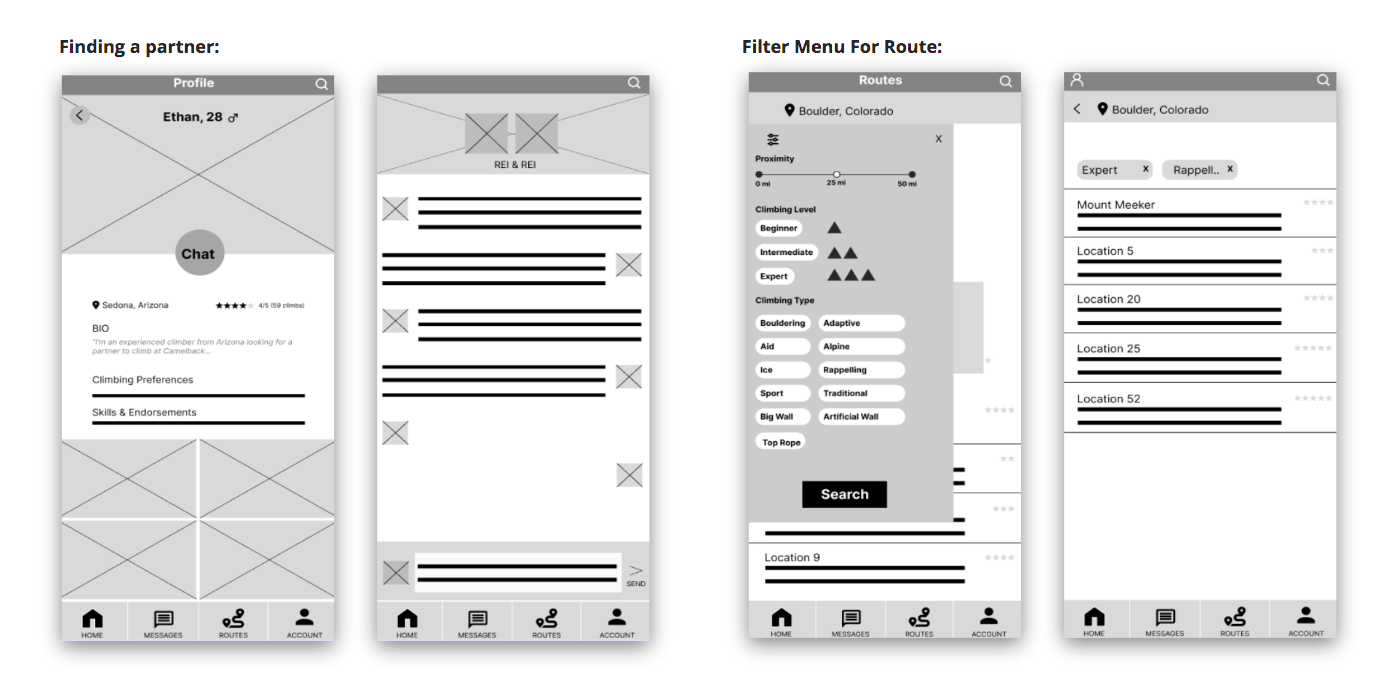04. Finding inspiration on how to build connections, establish trust, & share information
Competitive Analysis
We conducted an in-depth competitive analysis within the climbing industry, examining industry leaders such as AllTrails, Hiking Project, My Climb, and Mountain Project. Our objective was to identify their distinctive features and understand their primary objectives, serving as a source of inspiration to inform our project's direction.
Insights & Key Features:
- Offline tracking GPS
- Trail directory based on level of difficulty
- Logging & goal tracking
- Live trail condition & weather updates
Comparative Analysis
Our approach emphasized a comparative review, rather than direct competition. We drew inspiration from successful platforms such as Hinge, LinkedIn, WhatsApp, and GoogleMaps that successfully build user connections, establish trust, share information, and show contextual information.
How does Hinge help build user connections?
How does LinkedIn Establish Trust?
How does Whatsapp share information?
How does Google Maps show contextual information?

- Highlights personal information in digestible way
- Allows for easy connections and conversations with chat feature
- Skill endorsement and recommendation feature help establish trust by sharing verified information about users
- Allows users to share information of all formats; including location and contact information
- Highlights important context about different ideas and location, using features like star reviews and "about" sections
05. How can we solve the probelm?
Early Sketches
In the solution ideation phase, we used the insights from our user research as a foundation. We initiated the process with sketching, a quick and cost-effective method that facilitated brainstorming and feature prioritization. This approach allowed us to identify the most valuable features for climbers, including Austin, before diving into wireframing.

Feature Ideas & Prioritization
01. Ability to find a partner or group to climb with (dating app-like) ⟶
02. Real time weather and conditions report with live updates ⟶
03. Gamified goal tracking. ⟶
04. Community board social feed
Comprehensive climbing directory ⟶
Transferable User Insight:
01. Users struggle to find partners / groups to climb with that align to their busy schedules
02. Users feel more confident when prepared with the right information about climbing & weather conditions
03. Users strive to accomplish difficult climbing challenges
04. Users crave the social aspect of the climbing community
06. Let's build an app that helps climbers find trusted climbing partners
In shaping our solution, we made a deliberate choice to prioritize the development of a feature that helps climbers find trusted climbing partners. Our decision was rooted in the understanding that this was a paramount concern for our users, and the existing landscape lacked a clear, comprehensive solution.
Solution Statement
REI Climb, is an innovative app designed to address the most critical challenges faced by climbers. It provides a platform for climbers to connect with trusted partners, while also offering essential features such as route finding assistance, gear preparation support, and guides to enhance climbers' journeys.
07. The design process
Wireframing
In order to validate and test our ideas, we translated our concepts into visual representations. These wireframes acted as a blueprint for our app's layout, helping to visualize the user interface and interactions, setting the stage for the development of a user-friendly and effective design.

08. Does it work?
Usability Testing
Our team conducted a series of usability tests at various fidelities. These tests were instrumental in refining the information architecture and copy of our app. They provided us with a nuanced understanding of how users interacted with the interface, allowing us to make informed adjustments that ultimately led to an improved and user-friendly final product.
"Oh, I completely missed that! I didn't see the icon on the top of the screen"
01. Users didn't notice the filter Icon in the top left corner; if they did, then they thought it was associated with the menu bar, not finding a partner
02. Users either missed the share button completely or did not understand the iconography
03. Users were confused by the differences between recommended places and the rest of the results
04. Lack of homepage or directory caused users to keep clicking back button until they got to desired place
09. The final protoype (for now...)
Prototype & MVP
We incorporated the feedback from usability testing to create an improved mockup of our solution. Testing this version showed fewer hesitations and errors compared to previous ones, demonstrating its enhanced usability.

10. Reflection & retrospective
Future Steps
Created within a two-week timeframe, our prototype primarily focused on refining the path for finding climbing partners. However, if given more time, our team would aim to expand and enhance the app's functionality by incorporating features like live weather and condition reports and comprehensive climbing preparation resources, ensuring a more comprehensive solution for climbers. We would also specifically test the iconography further to see if users need the tagline associated with it, and created greater consistency among frames.
Lessons Learned
1. Quality Over Quantity: Prioritizing quality over quantity in user research and focusing on a well-defined target user group proved more valuable in gathering insightful and relevant feedback.
2. Project Management Tools: Utilizing project management tools, like Asana, was instrumental in helping to keep track of deliverables and timelines for our group. Establishing a structured and organized workflow allowed for better collaboration and ensured project milestones were met effectively.
3. Organized Structure in Team Collaboration: Working in Figma as a team underscored the need for a well-organized structure. Establishing guidelines and a framework is important to ensure everyone is on the same page, facilitating smoother communication and collaborative design efforts.















